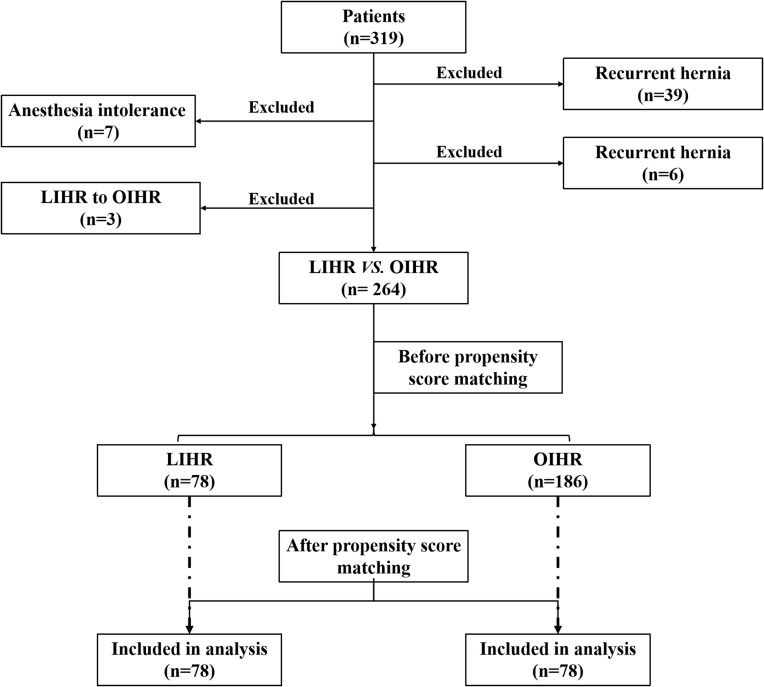Laparoscopic versus Open Inguinal Hernia Repair in Aging Patients: A Propensity Score Matching-Based Retrospective Study.
IF 2.3
3区 医学
Q2 HEALTH CARE SCIENCES & SERVICES
引用次数: 0
Abstract
Objective Although laparoscopic repair has been widely carried out and promoted due to its minimally invasive advantages, open surgery is still popular compared to elderly patients. This study aims to compare the outcomes of laparoscopic (LIHR) vs open repair of inguinal hernias (OIHR) in elderly patients. Methods A retrospective analysis of the database was performed to identify elderly patients, from January 2021 through December 2022, who underwent surgery for an inguinal hernia. After a 1:1 propensity score matching (PSM) with a caliper of 0.1 was conducted to balance potential bias, binary logistic regressions were used for categorical and continuous outcomes. Results After PSM, 78 pairs of elderly patients were enrolled in this study, and there were no significant differences in baseline between LIHR and OIHR groups. Compared to OIHR, univariable and multivariable logistic regression analysis showed that LIHR was independently affected for reducing intraoperative hemorrhage (OR = 0.06, 95% CI: 0.02–0.18, P < 0.001) and shortening postoperative hospitalization time (OR = 0.29, 95% CI: 0.15–0.57, P < 0.001) in elderly patients. Furthermore, LIHR (OR = 0.28, 95% CI: 0.14–0.57, P < 0.001) and age (OR = 0.89, 95% CI: 0.82–0.96, P = 0.002) were independent affecting factors for relieving postoperative pain. Meanwhile, no obvious differences were detected in postoperative complications [LIHR 7.7% (6/78) vs OIHR 14.1% (11/78), P = 0.199]. Conclusion LIHR was closely associated with reducing intraoperative hemorrhage and shortening postoperative hospitalization time. Whilst LIHR and age were independently affecting factors for relieving postoperative pain.

老年患者的腹腔镜与开放式腹股沟疝修补:一项基于倾向评分匹配的回顾性研究。
目的:虽然腹腔镜修复因其微创优势已被广泛开展和推广,但与老年患者相比,开放式手术仍受欢迎。本研究旨在比较腹腔镜(LIHR)与开放式修补老年患者腹股沟疝(OIHR)的效果。方法:对数据库进行回顾性分析,以确定从2021年1月到2022年12月接受腹股沟疝手术的老年患者。在以0.1的卡尺进行1:1倾向评分匹配(PSM)以平衡潜在偏差后,对分类和连续结果使用二元逻辑回归。结果:经PSM后,78对老年患者入组,LIHR组与OIHR组基线无显著差异。与OIHR相比,单变量和多变量logistic回归分析显示,LIHR对减少老年患者术中出血(OR = 0.06, 95% CI: 0.02-0.18, P < 0.001)和缩短术后住院时间(OR = 0.29, 95% CI: 0.15-0.57, P < 0.001)具有独立影响。此外,LIHR (OR = 0.28, 95% CI: 0.14-0.57, P < 0.001)和年龄(OR = 0.89, 95% CI: 0.82-0.96, P = 0.002)是术后疼痛缓解的独立影响因素。两组术后并发症无明显差异[LIHR 7.7% (6/78) vs OIHR 14.1% (11/78), P = 0.199]。结论:LIHR与减少术中出血、缩短术后住院时间密切相关。而LIHR和年龄是术后疼痛缓解的独立影响因素。
本文章由计算机程序翻译,如有差异,请以英文原文为准。
求助全文
约1分钟内获得全文
求助全文
来源期刊

Therapeutics and Clinical Risk Management
HEALTH CARE SCIENCES & SERVICES-
CiteScore
4.80
自引率
3.60%
发文量
139
审稿时长
16 weeks
期刊介绍:
Therapeutics and Clinical Risk Management is an international, peer-reviewed journal of clinical therapeutics and risk management, focusing on concise rapid reporting of clinical studies in all therapeutic areas, outcomes, safety, and programs for the effective, safe, and sustained use of medicines, therapeutic and surgical interventions in all clinical areas.
The journal welcomes submissions covering original research, clinical and epidemiological studies, reviews, guidelines, expert opinion and commentary. The journal will consider case reports but only if they make a valuable and original contribution to the literature.
As of 18th March 2019, Therapeutics and Clinical Risk Management will no longer consider meta-analyses for publication.
The journal does not accept study protocols, animal-based or cell line-based studies.
 求助内容:
求助内容: 应助结果提醒方式:
应助结果提醒方式:


